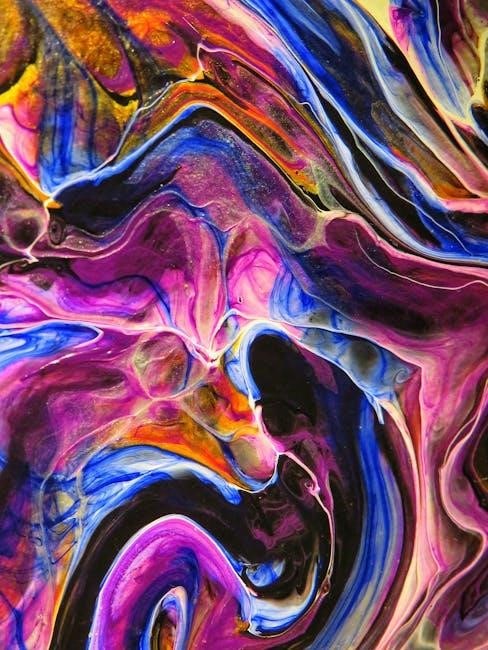Aesthetics and psychobiology explore the psychological and biological bases of aesthetic experiences, emphasizing exploratory behavior and emotional responses to art and design, as outlined in Berlyne’s influential work.

Overview of Berlyne’s Contribution
Daniel E. Berlyne’s work in Aesthetics and Psychobiology (1971) laid the foundation for understanding the psychological and biological mechanisms underlying aesthetic experiences. His theories emphasized the role of exploratory behavior, novelty, and arousal in shaping aesthetic preferences. Berlyne integrated concepts from motivation theory, information theory, and neurobiology to explain how humans respond to art and design. His research highlighted the importance of psychological principles in aesthetic appreciation, bridging the gap between art and science. Berlyne’s contributions remain influential in contemporary aesthetics research, offering a framework for studying the complex interplay between cognitive, emotional, and environmental factors in aesthetic experiences.

Relevance of the Topic in Modern Psychology
Berlyne’s work on aesthetics and psychobiology remains highly relevant in modern psychology, particularly in understanding the emotional and cognitive processes underlying aesthetic experiences. His theories on exploratory behavior and arousal provide a framework for studying how individuals interact with art and environments. The integration of psychological principles with neurobiological mechanisms offers insights into the universal aspects of aesthetic preference. Furthermore, Berlyne’s emphasis on environmental aesthetics aligns with contemporary research on wellbeing, highlighting the psychological benefits of aesthetically pleasing surroundings. His contributions continue to inspire interdisciplinary approaches, bridging psychology, art, and design to enhance our understanding of human emotional and cognitive responses.

Key Concepts in Berlyne’s Theory
Berlyne’s theory emphasizes exploratory behavior, arousal, and information theory, linking aesthetic experiences to psychological mechanisms that drive curiosity, emotional responses, and cognitive engagement with art and environments.
Exploratory Behavior and Aesthetics
Berlyne’s theory highlights exploratory behavior as a cornerstone of aesthetic experiences. He posits that individuals are driven to explore stimuli that offer optimal levels of complexity and novelty, which in turn trigger curiosity and engagement. This exploratory drive is not merely cognitive but also emotionally rewarding, as it satisfies intrinsic motivations for knowledge and pleasure. Berlyne argues that aesthetics emerges from this interaction between the individual and their environment, where the balance between familiarity and novelty determines the appeal of an artwork or design. Thus, exploratory behavior is central to understanding how aesthetic preferences and experiences are formed and sustained over time.
The Role of Arousal in Aesthetic Experience
Berlyne’s theory emphasizes arousal as a critical component in aesthetic experiences. He suggests that aesthetic encounters trigger physiological and psychological arousal, which influences emotional and cognitive responses. According to Berlyne, optimal arousal levels are achieved when stimuli balance complexity and novelty, avoiding both understimulation and overstimulation. This optimal state enhances engagement and pleasure, making arousal a key driver of aesthetic appreciation. Berlyne links this process to the brain’s reward system, where heightened arousal contributes to feelings of satisfaction and enjoyment. Thus, arousal serves as a mediator between environmental stimuli and subjective aesthetic experiences, shaping how individuals perceive and evaluate art and design. This concept remains central to understanding aesthetic responses.

Theories and Models of Aesthetic Appreciation
Berlyne’s work integrates psychological and neurobiological frameworks to explain aesthetic appreciation, emphasizing exploratory behavior and arousal as key drivers of aesthetic experiences and preferences in art and design.
Psychological Foundations of Aesthetic Preference
Daniel E. Berlyne’s work in Aesthetics and Psychobiology (1971) explores how psychological processes shape aesthetic preferences. He identifies key variables such as complexity, novelty, and uncertainty as central to aesthetic appeal. According to Berlyne, these factors stimulate curiosity and exploratory behavior, leading to heightened arousal and engagement. His theory suggests that aesthetic preference is rooted in the interplay between cognitive and emotional responses, influenced by individual differences in experiences and cultural backgrounds. This framework provides a comprehensive understanding of how psychological mechanisms drive aesthetic judgments and behaviors, emphasizing the role of both intrinsic and extrinsic factors in shaping artistic appreciation.
Neurobiological Mechanisms in Aesthetic Response
Berlyne’s psychobiological model highlights the neurobiological mechanisms underlying aesthetic responses, emphasizing the brain’s reward and arousal systems. Research indicates that aesthetic experiences activate regions like the prefrontal cortex, associated with complex processing, and the limbic system, linked to emotional responses. The release of dopamine during aesthetic pleasure suggests a neurobiological basis for enjoyment. Berlyne’s theory aligns with findings that novelty and complexity stimulate curiosity, engaging the brain’s exploratory networks. These mechanisms demonstrate how aesthetic responses are deeply rooted in neural processes, bridging art and psychology to explain why certain stimuli evoke emotional and cognitive reactions, shaping individual preferences and experiences. This interplay is central to understanding aesthetic appreciation.
Berlyne’s Psychobiological Model
Berlyne’s model integrates psychological and biological factors, explaining aesthetic experiences through information theory, exploratory behavior, and arousal, bridging art and science in understanding human responses.
Information Theory and Aesthetic Experience
Berlyne’s work integrates information theory with aesthetic experiences, suggesting that complexity, novelty, and uncertainty in stimuli influence aesthetic preference. According to Berlyne, aesthetic experiences arise from the interplay between exploratory behavior and arousal, shaped by the brain’s information-processing mechanisms. He proposed that aesthetic pleasure is linked to the optimal level of information processing, where neither too much nor too little complexity is present. This theory provides a framework for understanding how aesthetic experiences are rooted in psychological and neurobiological processes, emphasizing the role of information in shaping emotional and cognitive responses to art and design.
The Intersection of Art and Psychology
Berlyne’s work bridges art and psychology by exploring how aesthetic experiences are rooted in psychological processes. His theories emphasize the role of exploratory behavior, arousal, and emotional responses in shaping aesthetic preferences. By integrating psychological principles with artistic phenomena, Berlyne provides a framework for understanding the emotional and cognitive mechanisms underlying aesthetic appreciation. This intersection highlights the dynamic interplay between creativity, perception, and mental processes, offering insights into why certain stimuli evoke aesthetic pleasure. Berlyne’s approach remains influential, connecting art to psychological science and fostering interdisciplinary research in aesthetics and psychobiology.
Applications in Art and Design
Berlyne’s theories on aesthetics and psychobiology inform art and design by emphasizing the role of exploratory behavior and arousal in creating visually pleasing and emotionally engaging environments.
Environmental Aesthetics and Wellbeing
Berlyne’s work highlights the significance of environmental aesthetics in promoting psychological wellbeing. His theories suggest that certain visual stimuli, such as complexity and novelty, can enhance emotional balance and reduce stress. By understanding how aesthetic experiences influence mood and cognition, designers can create spaces that foster relaxation and productivity. Berlyne’s psychobiological model emphasizes the role of arousal in aesthetic appreciation, which can be applied to crafting environments that support mental health. This intersection of aesthetics and psychology underscores the importance of thoughtful design in enhancing overall wellbeing, making Berlyne’s contributions highly relevant to modern environmental psychology and urban planning.
Legacy and Influence

Berlyne’s seminal work in aesthetics and psychobiology has profoundly influenced contemporary research, shaping theories in art, psychology, and environmental design with enduring relevance.
Impact on Contemporary Aesthetics Research
Berlyne’s work has significantly shaped contemporary aesthetics research, inspiring studies on the psychological and neurobiological mechanisms underlying aesthetic experiences. His theories on exploratory behavior and arousal have influenced modern investigations into art appreciation, environmental aesthetics, and emotional responses to design. Researchers continue to build on his frameworks, integrating them with advances in neuroscience and cognitive psychology. Berlyne’s emphasis on the interplay between psychological processes and aesthetic preference remains a cornerstone in understanding how individuals perceive and value artistic and environmental stimuli, ensuring his legacy endures in both theoretical and applied aesthetics research.

Critiques and Controversies
Berlyne’s theories faced criticism for oversimplifying aesthetic experiences and lacking empirical support, with some arguing his models neglected cultural and contextual influences on perception.
Debates on the Universality of Aesthetic Theories
Debates surrounding the universality of aesthetic theories, particularly Berlyne’s psychobiological model, question whether aesthetic preferences are innate or culturally influenced. Critics argue that Berlyne’s emphasis on universal principles overlooks the role of cultural and contextual factors in shaping aesthetic experiences. While his theory suggests that certain stimuli inherently evoke aesthetic pleasure, others contend that aesthetic judgments are deeply subjective and vary across cultures. These debates highlight the tension between biological determinism and sociocultural constructs in understanding aesthetics, challenging the notion of a single, universal framework for aesthetic appreciation. This critique underscores the complexity of aesthetic experiences beyond purely biological explanations.
